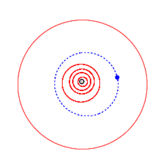(9942) 1989 TM1
|
| |
| Discovery [1] | |
|---|---|
| Discovered by |
T. Hioki N. Kawasato |
| Discovery site | Okutama Obs. (877) |
| Discovery date | 8 October 1989 |
| Designations | |
| MPC designation | (9942) 1989 TM1 |
| 1989 TM1 | |
| main-belt · (inner) [2] | |
| Orbital characteristics [1] | |
| Epoch 31 July 2016 (JD 2457600.5) | |
| Uncertainty parameter 0 | |
| Observation arc | 26.64 yr (9,732 days) |
| Aphelion | 3.0286 AU |
| Perihelion | 2.1661 AU |
| 2.5974 AU | |
| Eccentricity | 0.1660 |
| 4.19 yr (1,529 days) | |
| 123.63° | |
| 0° 14m 7.8s / day | |
| Inclination | 9.9386° |
| 21.749° | |
| 38.553° | |
| Physical characteristics | |
| Dimensions |
4.12±0.45 km[3] 4.73 km (calculated)[2] |
| 3.0706±0.0004 h[4] | |
|
0.20 (assumed)[2] 0.454±0.106[3] | |
| S [2] | |
|
13.40[3] 13.541[4] 13.6[1] 13.72±0.39[5] 13.99[2] | |
|
| |
(9942) 1989 TM1 is a stony asteroid from the inner regions of the asteroid belt, approximately 4.5 kilometers in diameter. It was discovered on 8 October 1989, by Japanese astronomers Nobuhiro Kawasato and Tsutomu Hioki at Okutama Observatory (877), Japan.[6]
The stony S-type asteroid orbits the Sun at a distance of 2.2–3.0 AU once every 4 years and 2 months (1,529 days). Its orbit has an eccentricity of 0.17 and an inclination of 10° with respect to the plane of the ecliptic.[1] A precovery was taken at the U.S. Palomar Observatory on 30 September 1989, extending the asteroid's observation arc by just 9 days prior to its discovery.[6]
In October 2010, a rotational light-curve for this asteroid was obtained from photometric observations at the U.S. Palomar Transient Factory, California. It rendered a tentative rotation period of 3.0706±0.0004 hours with a brightness variation of 0.08 in magnitude (U=1).[4]
The asteroid was predicted to cross the focal plane array of the Infrared Astronomical Satellite (IRAS). However, it was missed on each of its seven planned observation and was never detected. According to the "missed predictions file" of the supplemental IRAS minor planet survey (SIMPS), the body was expected to have a diameter of 13.5 kilometers and an absolute magnitude of 13.20.[7] Based on an absolute magnitude of 13.99, and an assumed standard albedo for stony asteroids of 0.20, the Collaborative Asteroid Lightcurve Link calculated a much smaller diameter of 4.7 kilometers,[2] which agrees with a diameter of 4.1 kilometers, found by NASA's Wide-field Infrared Survey Explorer with its subsequent NEOWISE mission.[3]
References
- 1 2 3 4 "JPL Small-Body Database Browser: 9942 (1989 TM1)" (2016-05-23 last obs.). Jet Propulsion Laboratory. Retrieved 4 July 2016.
- 1 2 3 4 5 6 "LCDB Data for (9942)". Asteroid Lightcurve Database (LCDB). Retrieved 4 July 2016.
- 1 2 3 4 Masiero, Joseph R.; Mainzer, A. K.; Grav, T.; Bauer, J. M.; Cutri, R. M.; Nugent, C.; et al. (November 2012). "Preliminary Analysis of WISE/NEOWISE 3-Band Cryogenic and Post-cryogenic Observations of Main Belt Asteroids". The Astrophysical Journal Letters. 759 (1): 5. arXiv:1209.5794
 . Bibcode:2012ApJ...759L...8M. doi:10.1088/2041-8205/759/1/L8. Retrieved 4 July 2016.
. Bibcode:2012ApJ...759L...8M. doi:10.1088/2041-8205/759/1/L8. Retrieved 4 July 2016. - 1 2 3 Waszczak, Adam; Chang, Chan-Kao; Ofek, Eran O.; Laher, Russ; Masci, Frank; Levitan, David; et al. (September 2015). "Asteroid Light Curves from the Palomar Transient Factory Survey: Rotation Periods and Phase Functions from Sparse Photometry". The Astronomical Journal. 150 (3): 35. arXiv:1504.04041
 . Bibcode:2015AJ....150...75W. doi:10.1088/0004-6256/150/3/75. Retrieved 4 July 2016.
. Bibcode:2015AJ....150...75W. doi:10.1088/0004-6256/150/3/75. Retrieved 4 July 2016. - ↑ Veres, Peter; Jedicke, Robert; Fitzsimmons, Alan; Denneau, Larry; Granvik, Mikael; Bolin, Bryce; et al. (November 2015). "Absolute magnitudes and slope parameters for 250,000 asteroids observed by Pan-STARRS PS1 - Preliminary results". Icarus. 261: 34–47. arXiv:1506.00762
 . Bibcode:2015Icar..261...34V. doi:10.1016/j.icarus.2015.08.007. Retrieved 4 July 2016.
. Bibcode:2015Icar..261...34V. doi:10.1016/j.icarus.2015.08.007. Retrieved 4 July 2016. - 1 2 "9942 (1989 TM1)". Minor Planet Center. Retrieved 4 July 2016.
- ↑ Tedesco E.F.; Noah P.V.; Noah M.; Price S.D. "The supplemental IRAS minor planet survey (SIMPS) – Missed-Predictions". Retrieved 1 January 2016.
External links
- Asteroid Lightcurve Database (LCDB), query form (info)
- Dictionary of Minor Planet Names, Google books
- Asteroids and comets rotation curves, CdR – Observatoire de Genève, Raoul Behrend
- Discovery Circumstances: Numbered Minor Planets (5001)-(10000) – Minor Planet Center
- (9942) 1989 TM1 at the JPL Small-Body Database

